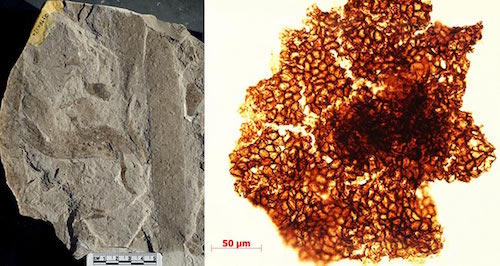 Evolution
Evolution
Could This Be the Oldest Evidence Yet for Multicellular Eukaryotes?

Writing in the journal Nature Communications, Zhu et al. describe new fossil evidence from 1.56-billion-year-old mudstones in North China. The authors interpret these fossils as the oldest record of multicellular eukaryotes so far. But their enthusiasm looks premature.
Interviewed by The Guardian, the first author, Maoyan Zhu, raves: “This totally renews current knowledge on the early history of life.” The newspaper’s headline echoes the sentiment, reporting: “Complex life on Earth began billion years earlier than previously thought.” Science News is even more excited: “1.56-billion-year-old fossils add drama to Earth’s ‘boring billion.'” Renowned paleobiologist Philip Donoque at the University of Bristol agrees the discovery is a “big deal” and the fossils “are certainly the oldest demonstrably multicellular eukaryotes.”
Yet there were already other, older contenders considered to be the earliest multicellular eukaryotes, most notably Grypania spiralis, coiled filamentous fossils from Proterozoic strata that are 1.3-2.1 billion years old. Grypania most likely represents a multicellular “eukaryotic alga because of its complexity, structural rigidity, and large size.” However, Zhu and his colleagues dismiss Grypania as a serious candidate for the title of oldest multicellular eukaryote, since, they say, “Both the cellular structure and phylogenetic affinities of these fossils remain uncertain.” This is strange, though, as one of the main authors wrote a few years ago that thesefossils are “most confidently interpreted as eukaryotic.“
The newly described fossils from China are linear, oblong, or tongue-shaped carbonaceous compressions a decimeter long. There is evidence for linear striations, apical growth, and a basal holdfast, suggesting a sessile marine way of life.
The preparation method of acid maceration yielded isolated cell sheets with a multi-layered network of polygonal cells from the same sediments, but no evidence for cell differentiation or different types of tissue organization. However, Zhu et al. hasten to say:
We cannot unambiguously demonstrate that the cell sheets originated within the thalli, but the absence of other microscopic fossils or other evident sources for these fragments, and indeed the absence of comparable cell sheets with dimensions 41mm in any known Mesoproterozoic deposit, makes attribution of the cell sheets to the macroscopic thalli reasonable.
Indeed, the fact that no such cell sheet could be discovered in situ of any of the numerous macrofossils suggests that they are of different origin. There is no reason why they should only be preserved in isolated form in the same sediments, but never in the same location as any of the 167 macrofossils. Consequently, there is not only zero evidence that these cell sheets have anything to do with the macrofossils, but there is positive evidence against such an assumption.
Even if these cell sheets did belong with the macrofossils, they would not prove an attribution to Eukaryota, as no nuclei or any other cell structures typical for eukaryotic cells are visible. Furthermore, the differentiation of the thalloid fossils into a tongue-shaped part and a holdfast is not even a clear indication for multicellularity, as such differentiations are also found in some temporal protist aggregations like aquatic slime molds.
In their article’s discussion, Zhu et al. mention that, “On the basis of the comparisons with modern organisms, the thalli were most likely photosynthetic, although one can imagine a possible osmotrophic alternative.” However, except for this very brief statement, there is no documentation of such a comparison, either in the main article or in the supplementary information. No detailed comparative analysis is provided and no specific similarities are established. No phylogenetic analysis is presented either, and no derived homologue structures are identified that could support an attribution to Eukaryota or one of its subgroups.
Nevertheless, Zhu et al. confidently claim, “The new fossils provide the strongest evidence yet that multicellular eukaryotes with decimetric dimensions and a regular developmental program populated the marine biosphere at least a billion years before the Cambrian Explosion.”
That may or may not be true, but the article hardly provides compelling evidence for the bold assertion. Just a sentence earlier, the authors admit that their “phylogenetic placement within the Eukaryota remains uncertain,” even as the main text again claims, “We emphasize that the interpretation of the thalli as macroscopic eukaryotes is strong regardless of how one evaluates the cell sheets.” This boils down to the self-contradictory proposition that the phylogenetic placement in Eukaryota is at the same time uncertain and strongly supported.
That such blunder nowadays can pass as proper science in the most prestigious scientific journals, enthusiastically received by some distinguished Darwinian scientists, tells you something about the pseudoscientific nature of large parts of evolutionary biology.
Fortunately, some scientists retain a more skeptical perspective, like Oxford’s Jonathan Antcliffe who states, “There is nothing here to suggest that the specimens are eukaryotic, as opposed to bacterial,” or Abderrazak El Albani at the University of Poitiers in France, who complains that the level of detail in the study was “absolutely insufficient to tell us if these organisms were multicellular, eukaryotes or complex.”
Not least when it comes to evolutionary biology, science and science reporting could do with more such skepticism.
Photo credit: Maoyan Zhu, via Nanjing Institute of Geology and Paleontology.
